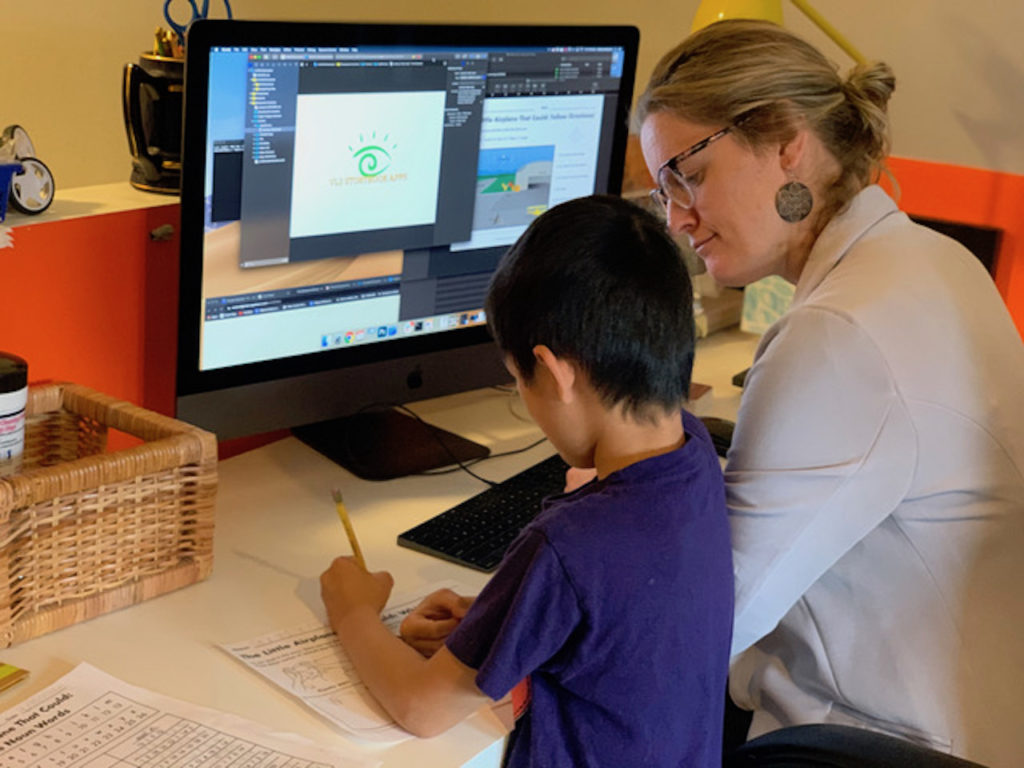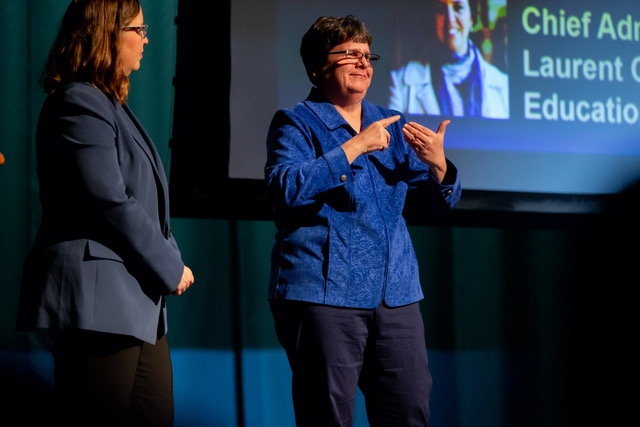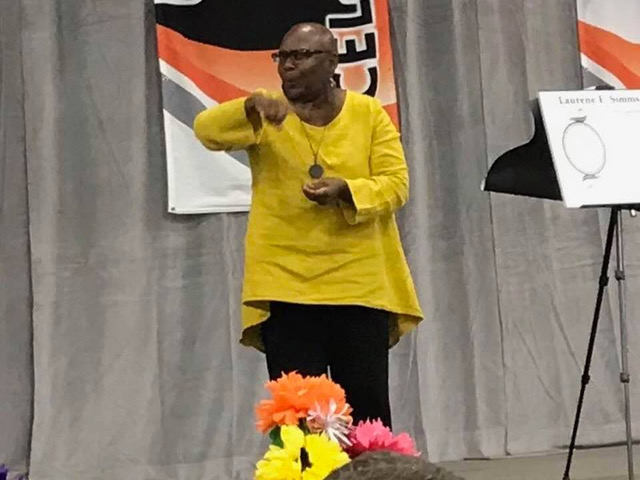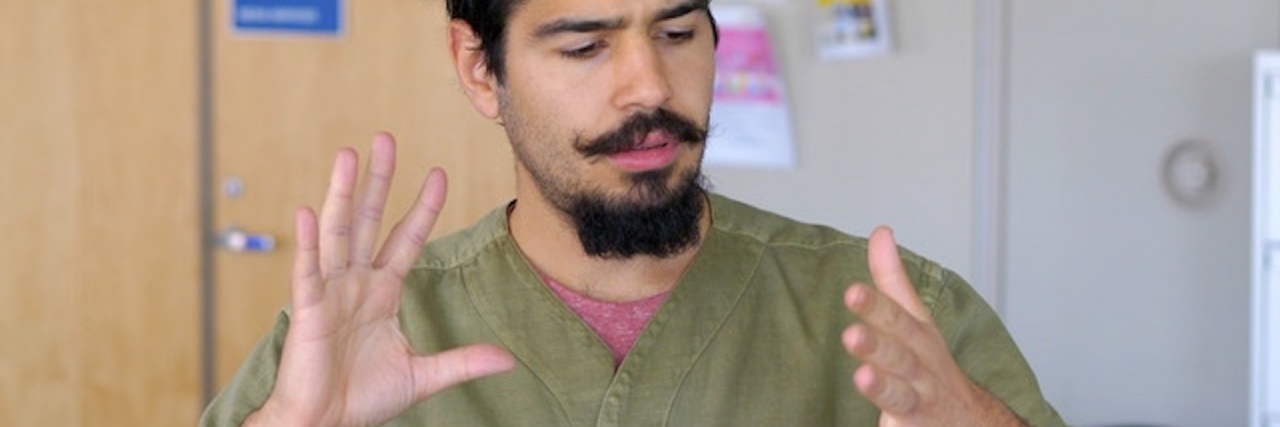How to Support Deaf Students During COVID-19
Editor's Note
Join The Mighty’s Coronavirus group to connect with other Mighties living through the pandemic. Read the latest updates, share helpful tips, or give and receive virtual support.
To prevent the spread of SARS-CoV-2, the coronavirus that causes COVID-19, schools nationwide have moved learning online for thousands of students. While the COVID-19 pandemic is challenging for students, families and teachers alike across the board, resources for the Deaf community in both American Sign Language (ASL) and English have been slow to catch up.
“Because of COVID-19 pandemic, we as a Deaf community have experienced numerous challenges,” Dr. Laurene Simms, chief bilingual officer at Gallaudet University, told The Mighty, adding:
For one, still not all 50 states have ASL interpreters and these leaves out the signing Deaf community during live televised warnings and updates. Secondly, many Deaf persons need health and safety information translated into ASL at a more rapid pace than is currently provided. Thirdly, we need to get our teachers up to speed to provide first-class online learning and instruction using both languages.
To learn more about how families, teachers and communities can better support Deaf students’ education during the COVID-19 pandemic, we asked for advice from Simms; Marianne Belsky, chief academic officer at Laurent Clerc National Deaf Education Center at Gallaudet University; and Melissa Malzkuhn, founder and creator of Motion Light Lab at Gallaudet University, who also parents a Deaf child.
Here’s what they told us:
Editor’s note: This roundtable has been edited for content and clarity.
What are some of the unique challenges of online schooling for kids who are deaf?
Malzkuhn: I think all children face unique challenges of “remote and online, distance learning”, especially at a young age. Their classrooms are play-based, hands-on, and structured for a lot of activities.Remote learning strips all that away. It’s a huge adjustment turning from that to screen-based learning. Deaf children face a number of tremendous challenges, though.
To start with, do their families sign? Over 95% of Deaf kids are born to hearing families. Research has shown that when families sign (even when they are learning to sign), it has a huge positive impact on a child’s language development, which leads to strong literacy skills. For many deaf children, bilingual schools with deaf teachers and staff provide the language models they need. To have that taken away, it’s a huge challenge. Parents, hopefully, can find the resources they need to keep signing (and there are resources!).
Yet another challenge is the free resources that are being given out to families by educational companies with good intentions — a majority of the resources online rely heavily on audio. I have gotten so many recommendations for online interactive learning materials. When I check them out, I find they have captions, which is a good thing, but captions aren’t effective when we are talking about young deaf children who are learning to read. They need American Sign Language (ASL) materials to help them bridge from ASL to English and learn how to read.

How have deaf students been adapting their learning as they move to at-home and online education?
Belsky: We are finding that many students with a high degree of electronic and internet literacy are making the transition more easily, and can pick up new technologies more quickly. Many students are already comfortable or familiar with interacting through video. What’s different is that we’ve reached the tipping point where these digital interactions have now become the standard, default way to engage their teachers and peers, and not a supplementary to in-person classroom learning as before. We are all adjusting to our new routines and lives, and need to be mindful of the different kinds of benefits and costs involved in asking students to engage more in these online spaces. Digital fatigue is a real thing.
Students are very resilient and highly adaptable, but it can be tough for teachers without that immediate feedback they get with in-person instruction. To add to these challenges, we have many families that do not share a language with their children, which adds to the difficulty of parent support for classwork. The quality of technology and data needed for clear video transmission presents an added layer of challenge for deaf students and teachers. Also, eye strain and fatigue is a real issue. It’s been interesting working with videoconferencing apps that prioritize screen space based on sound. This makes watching and engaging with other signers challenging, especially with large groups, where multiple tiny boxes are on a screen all at once.

How can families help Deaf students find a new routine and continue learning now that we’ve transitioned to the home?
Simms: During this COVID-19 pandemic, families must handle their own work-at-home schedule with the homeschooling of one or more children, some of whom are Deaf. This is a challenge! We recommend families set up a Monday through Friday routine of completing online assignments from teachers (if available), book reading, watching ASL videos (YouTube) and writing English. Families can determine how long the “school at home” day is depending on the needs of the child. For a high school student, 9 a.m. to 3 p.m. is not unreasonable with an hour off for lunch. By establishing a routine, families can provide Deaf children and youth with direction, security and feelings of accomplishment as they finish daily tasks. This routine will also allow families to complete their own work assignments for their jobs as well as leaving family time for meals and enjoyment.

Belsky: It is important that students get grounded through connection to their peers and teachers, which is why we have set up a regular schedule of online face-to-face video interactions. Making many of the rituals and routines we had at school part of everyday life in the home goes a long way. We know everyone is balancing multiple people’s lives at home, and learning and working from home and building schedules can be challenging. Where possible, build non-school activities in similar patterns to the school day and alternate activities to give the brain and the eyes a break — starting with a morning physical activity to wake everyone up, then school work, a recess break, lunch, more school work, a family activity, then play hour and finally dinner, etc.
What resources do you recommend for deaf students now at home to make their education more accessible?
Malzkuhn: Because of how many educational materials are not ASL-accessible for Deaf children, my lab (Motion Light Lab) decided to step up and create and curate free resources for deaf children that are provided in a way that is clear, easy-to-understand and very easy to use. We want to create a sense of community and support parents who are feeling overwhelmed, scared, worried, and unsure of how to provide language models or ASL/English bilingual lessons to their kids. So, we are working to share our award-winning ASL/English bilingual storybook apps into fun weekly educational ASL/English activities. We’ve set up ASL Literacy Activities providing ASL storytelling on livestream with voice-over, worksheets, ASL-English literacy lessons live stream, arts & crafts activities and fun, interactive ASL-friendly quizzes. We have themed days too, for simplicity and fun. Our storybook apps are being offered free too, on a rolling basis. Everything on this platform is developed by an all-Deaf team.
Simms: I want to make a point here. Teachers need to be sensitive to families of color with Deaf students. Many are in vulnerable job positions during the COVID-19 outbreak such as in-home health, nursing home care and other service industries. Many must still take public transportation. So, these Deaf students may be home alone without parental supervision. Other family members may have been laid off from restaurants and small businesses and may be feeling extreme financial stress.
We also recommend that Deaf students of all ages watch the Daily Moth for daily news. This ASL programming available for free on Facebook provides a daily social studies class in current events for younger Deaf students and youths and a “catch-up” with the national news for older students. Viewing the Deaf Moth can assist hearing ASL learners to practice their ASL receptive skills. There are also numerous videos in ASL on YouTube related to content areas in science, social studies, health, math and other related content areas that Deaf students from kindergarten to college level can access.
Thursday, April 23 coronavirus updates
Thursday, April 23 coronavirus updates: 4.4 million more unemployed; Trump opposes Georgia reopening; Sweden not on lockdown; Sen. Warren brother dies from COVID-19; Rep. Maxine Walters sister dying; House to pass $484 billion package; Gov. Cuomo announces antibody test results; 7 die in storms; NFL draft done remotely; Ramadan begins tomorrowTranscript: https://www.dailymoth.com/blog/thursday-april-23-coronavirus-updates
Posted by The Daily Moth on Thursday, April 23, 2020
Belsky: We recognize that families have various levels of proficiency in ASL. Right now, we recommend just focusing on connecting with your child. Don’t be afraid to gesture, to be engaged, to show by doing. Show them how to cook, to build, to draw. Do things together. Eventually, with guidance, kids will be able to create their own approaches independently. Use your phone to text back and forth to practice written language skills and to communicate. You could even use voice recognition apps to support your communication and connection.
Anything additional you would like to add?
Malzkuhn: I’m coming into this as a creative and a storyteller who has been creating and developing bilingual storybook apps based on research to support literacy development in deaf children. I’ve established a lab, a team and we’ve done training. I am also a parent. I have a Deaf 7-year-old son, and through this I found myself feeling majorly overwhelmed. If someone like me, educated and familiar with Deaf education, ASL/English materials, feels overwhelmed about figuring out daily activities, I cannot imagine how many parents are feeling. This is why we are approaching this with a very upbeat feel, to do as much as we can in offering something to add to children’s lives every week with a storybook app. Young kids are already being put through a lot — let’s enrich their worlds with imagination, excitement, stories, fully accessible in their natural sign language, and keep their spirit for learning going strong.
Belsky: This is a rapidly developing situation, and things are changing every hour. We recognize there’s a national need for families to support their children’s learning and will be bringing together teams to think about what the different scenarios and types of education might look like both in the short term and the long term. This pandemic has changed education forever — while we will go back to traditional schools at some point, distance/digital learning will continue to be an integral part of our educational methods going forward. We are using the power of our collective imagination to think about where the opportunities are to transform deaf education, instead of just seeking a digital replacement for traditional face-to-face schooling. It’s both scary and exciting all at once.
Join our #TerrificThursday with Museum of Errors' crafts and activities! Want to make your own parrot bookmark, build your own dream room, draw your favorite person, and color the coloring pages? Let's have a GREAT time at the Weird World where everything is perfectly wrong! ???? pic.twitter.com/y8hhb0Q7EJ
— Motion Light Lab (@MotionLightLab) April 23, 2020
You can access additional Deaf education resources recommended by these experts at the following sites:
- Access Motion Light Lab’s bilingual educational resources by signing up on the website and subscribing to the YouTube channel
- Visit the Laurent Clerc Center’s website
- National Deaf Education Conference Unit has a website designed for families and Deaf children at home
- Transformative Deaf Education, designed for educators
Header image via Javier Tabares (pictured), creative team leader ASL Connect, and courtesy of ASL Connect

